Shop! Read! Watch! Listen!
Fair Trade

Recycled Handmade Mayan Luggage Tag
These unique and brightly colored handmade luggage tags will help you spot your bags quickly! Tags measure 3” wide by 5” long. They are made with recycle huipiles, which are the colorful, hand-woven blouses indigenous women wear in Guatemala. The back sides of the tags are made with a sturdy, clear plastic that will hold your business card or other address label.
The cord is 6” long for easy looping around your luggage handle. Tags come in a variety of bright colors and make a great, inexpensive gift for the avid traveler. Please choose black, blue, green, purple, or red. (See all color choices on the web page.) Only $7 each at MayaWorks
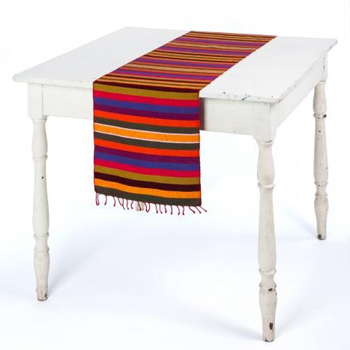
Striped Agua Caliente Guatemalan Runner
Maya Works’ hand-woven, brightly colored runner is named after the talented artisans who create it in the tiny community of Agua Caliente (meaning ‘Hot Water’) near the city of Chimaltenango in Guatemala. This beautiful piece of art is an array of bright striped colors from yellow, red, green, pink, purple, white and orange. The bright design makes this table runner very versatile. One can display it for a holiday or leave it out year round to add color to any room. Hand-woven on a treadle foot loom, this runner is woven in 100% cotton threads and can be washed in cold water and line dried.
Available in 60” and 80” lengths for $30 at MayaWorks
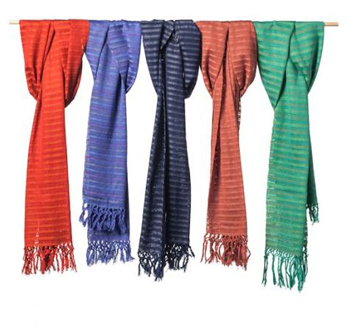
Mayan Hand-woven Cotton Scarves
Each scarf is carefully handcrafted by a Maya artisan, making this a very special addition to your wardrobe. The beautiful weave of this fabric includes subtle stripes of complimentary colors that give the scarves a unique, two-toned look. Each scarf is approximately 9” wide and 6 ½’ long, lending itself to endless style possibilities. Available in midnight blue, southern rose, carnival (purple), emerald forest (green) and sun flare (orange), there is a scarf to fit every season and every outfit.
Only $21 each at MayaWorks
Explore additional products at MayaWorks
Books
Fiction
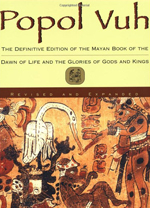
Translated by Dennis Tedlock
(Touchstone, 1996) Recommended by Maya Works
Popol Vuh is the Quiché Mayan book of creation dating back to the mid-1500s. Not only the most important text in the native languages of the Americas, it is also an extraordinary document of the human imagination. It begins with the deeds of Mayan gods in the darkness of a primeval sea and ends with the radiant splendor of the Mayan lords who founded the Quiché kingdom in the Guatemalan highlands. Originally written in Mayan hieroglyphs, it was transcribed into the Roman alphabet in the sixteenth century.
“The volume is required reading for everyone seriously interested in Native American literature or in Meso-American cultural history.”
– Los Angeles Times
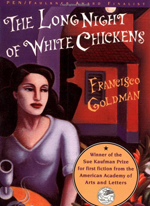
The Long Night of White Chickens
by Francisco Goldman
(Grove Press, 1998)
This novel is the story of Roger Graetz, raised in a Boston suburb by an aristocratic Guatemalan mother, and his relationship with Flor de Mayo, the beautiful young Guatemalan orphan sent by his grandmother to live with his family as a maid. When, years later in the 1980s, Flor is murdered in Guatemala while running an orphanage, Roger returns to uncover the truth of her death. There he is reunited with Luis Moya, a childhood friend, and together they attempt to chronicle Flor’s life story, a quest that will have unexpected, and unforgettable repercussions.
“While trying to uncover the facts surrounding Flor’s death, Roger recounts the elaborate events of his family life, giving us an engrossing and colorful picture of American and Guatemalan culture. Recommended for all fiction collections.”
– David Berona, Library Journal
Non-Fiction
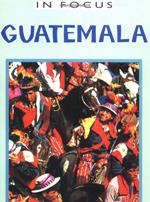
by Trish O’Kane
(Latin American Bureau, 1998)
Guatemala is the most “Indian” of Central American nations, and Mayan culture permeates many aspects of language, dress and artistic expression, according to the book’s publisher. This concise book (less than 100 pages) serves as a quick read to begin to gain interesting and in-depth knowledge about the country. Chapters include: History, Politics, Economy & Society, and Religion & Culture. Numerous photos and maps also make this book easy to follow and understand.
“Coverage of healthcare, racial equality, peace processes, and environmental concerns in the Amazon rainforest is informative and well researched. Practical advice, further readings, and useful addresses along with non-tourist travel information are listed at the end.”
– A. Stephanie Papa, Library Journal
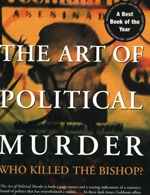
The Art of Political Murder: Who Killed the Bishop?
by Francisco Goldman
(Grove Press, 2008)
Bishop Juan Gerardi, Guatemala’s leading human rights activist, was bludgeoned to death in his garage on a Sunday night in 1998, two days after the presentation of a groundbreaking church-sponsored report implicating the military in the murders and disappearances of some 200,000 civilians. Realizing that it could not rely on police investigators or the legal system to solve the murder, the church formed its own investigative team, a group of secular young men in their twenties who called themselves the “Untouchables.” Author Goldman spoke to witnesses no other reporter has reached, and observed firsthand some of the most crucial developments in the case.
” The Art of Political Murder is both a page-turner and a searing indictment of a corrosive brand of politics that has overwhelmed a nation . . . In these dark times, Goldman offers a rare gift: a reason for hope, a story about the limits of impunity, an improbable and inspiring case study of success.”
– Daniel Alarcón, San Francisco Chronicle
Films
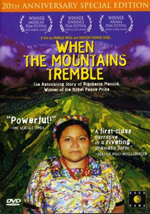
When the Mountains Tremble
(90 minutes, 1983)
Filmed amidst the bloody confrontation between Guatemala’s military and virtually unarmed Mayans, this Sundance award-winning documentary chronicles the amazing story of Rigoberta Menchú.
“Directors Pamela Yates and Newton Thomas Sigel did their own camerawork and managed to get behind-the-scenes shots of the Mayans and also the military, many of whom had no idea why they were persecuting the peasants. Menchu would go on to win the Nobel Peace Prize, and “When the Mountains Tremble” would go on to win a special jury award at the Sundance Film Festival, a blue ribbon award at the American Film Festival, and the Grand Coral Award at the Havana Film Festival (some of the interviews with survivors were of exiles living in Cuba).” – Movie Metropolis
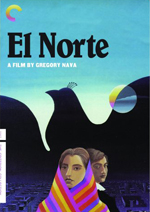
(140 minutes, 1983) Recommended by Maya Works
When the army ransacks their Guatemalan village, impoverished teenage siblings Enrique (David Villalpando) and Rosa (Zaide Silvia Gutiérrez) travel north through Mexico, hoping for a better life in America as undocumented immigrants in this Oscar-nominated drama. Kind souls aid their trek northward, but criminals and a persistent fear of deportation also dog their every move.
“From the very first moments of “El Norte,” we know that we are in the hands of a great movie. It tells a simple story in such a romantic and poetic way that we are touched, deeply and honestly, and we know we will remember the film for a long time.”
– Roger Ebert
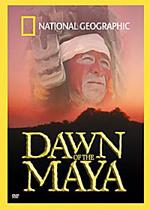
(56 minutes, 2004)
With little evidence to illuminate its history, pre-classic Maya civilization was long thought to be a primitive culture. But recent archaeological findings reveal that the ancient Maya were in fact an advanced and sophisticated people. National Geographic treks through the jungles of Guatemala to reveal discoveries about this great civilization, which produced elaborate art, developed an early writing system and built immense pyramids.
The 52-min. film can also be viewed online at http://www.snagfilms.com/films/title/dawn_of_the_maya
Music
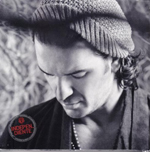
Ricardo Arjona is a Guatemalan singer-songwriter and former basketball player. One of the most successful Latin American artists of all time, he has sold more than 20 million albums. Arjona’s music ranges from ballads to Latin pop, rock, Cuban music, and more recently a cappella performances. Noted for his lyrical style, Arjona often addresses controversial topics such as homosexuality, kidnapping, rape, racism and immigration.
Arjona has released 13 studio albums, one live album, nine compilation albums and 43 singles. Four Arjona albums reached number one on Billboard’s Top Latin Albums, and ten reached number one in Argentina. His work has earned him numerous accolades, including one Grammy, one Latin Grammy and awards from the American Society of Composers, Authors and Publishers.
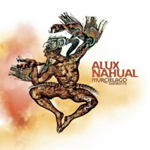
Alux Nahual is a Latin rock band formed in 1979 by brothers Plubio and Alvaro Aguilar, and their cousin Ranferí Aguilar. Also known as Espíritu del Duende in Spanish or Spirit of the Goblin in English – a Maya-quiche phrase naming a goblin similar to a leprechaun or elf. The band could very well be the best rock band Guatemala has produced. Their style is characterized by the incorporation of classic instruments like the cello and the flute to rock tunes, ballads and folk songs. They played and recorded together from 1979 to 1999.
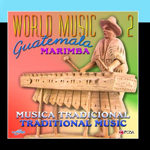
World Music Guatemala 2 – Musica Tradicional
Adverse impacts on the practice and intergenerational transmission of traditional music have included government genocide against the Maya from the 1960s forward, the massive creation of political and economic refugees, ongoing emigration to Mexico and the United States, extensive conversion efforts by U.S. evangelicals, and the impact of Ladino cultural dominance and international popular culture.
However, the whistles, flutes (of cane, clay, or metal), and drums of contemporary Maya music continue to reflect pre-Columbian roots, augmented by the adaptation of the marimba (first noted in late seventeenth-century reports) and indigenous variations on European stringed instruments including guitar, violin, and harp.
